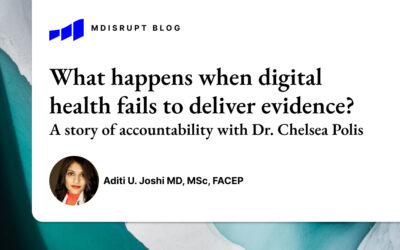Most healthtech companies say they want to be patient-centric, and for good reason. You can’t expect your products to be embraced by patients—or by providers—if you don’t understand patients’ needs and how your products fit into patient care.
But healthtech companies, especially in the early stages, often aren’t aware of an excellent, efficient way to build patient-centricity into their organization: by engaging with the patient advocacy sector.
Patient-centricity, defined
What, exactly do we mean by patient-centricity? Here’s a research-based definition I like:
“Putting the patient first in an open and sustained engagement of the patient to respectfully and compassionately achieve the best experience and outcome for that person and their family.”
This definition encompasses five clear themes of importance:
- Inclusiveness
- Working toward goals that are patient- and family-centered
- Empowering patients to take control of their health
- Collaborating in a way that shows respect, compassion, and openness
- Working in partnership
What patient advocacy can do for your company
Patient advocacy organizations, through their established relationships with a wide variety of key stakeholders in their space, can help you to build these patient-centric approaches into your company’s operations by:
- Identifying and operationalizing strategic objectives around the patient perspective
- Tracking progress against KPIs and ROI goals
- Harnessing digital and data analytics opportunities to engage patients, improve their experience, and collect data on outcomes and unmet needs
- Collaborating more deeply with, and learning from, other industries
- Building a comprehensive map of the patient influencers and advocacy organizations aligned with your key business objectives
- Mapping strategic priorities and long-term plans for engagement
Engage early
To build a patient-centric company, it’s essential to establish working relationships with patient advocacy groups early on. This will help ensure that patient engagement is baked into the definition of company objectives throughout your organization. It’s the key to establishing and optimizing patient trust and outcomes, developing more effective clinical trials and studies, understanding the workflows of patient care and treatment needs, and advancing commercialization.
What patient advocacy experts bring to the table
Experienced professionals in this sector bring a deep understanding of the patient advocacy communities, how they interact with industry, and how to create partnerships that benefit all stakeholders.
- Engaging a patient advocacy professional in a part-time or consulting capacity can help to:
- Oversee partnership and engagement strategy with patient advocacy groups
- Establish company leadership within the broader patient advocacy community, and champion the patient perspective within the company
- Define vision and mission for patient advocacy and build strategy that reflects the company’s commitment to patient and advocate engagement
- Build an infrastructure to ensure that a company’s advocacy strategy and programs advance the interests the company shares with advocates, from development to commercialization
- Champion the patient perspective and deliver strategic insights on program and corporate strategy to company leaders
- Foster a patient-centric culture by directly connecting employees to the patient experience through innovative corporate programs and activities
- Drive clinical trial design, awareness, and patient identification initiatives to support rapid trial enrollment and execution.
I have experience building patient advocacy strategies from scratch by analyzing the needs of the patient community and using partnerships and collaborations to provide resources that meet those needs. My expertise includes:
- Extensive knowledge of the competitive landscape impacting healthtech
- Providing strategic direction to ensure management and development of patient engagement programming
- Analyzing key industry trends, make recommendations on patient engagement opportunities.
- Developing collaborative patient advocacy partnerships
- Excellent project management and organizational skills with the ability to seamlessly multi-task and lead multiple high-priority, time-sensitive initiatives in parallel
- Conducting analysis of patient advocacy landscape
- Development of comprehensive advocacy partnership and strategic framework
- Patient-focused clinical trial design
A real world example
I worked with a patient advocacy organization to develop a patient workshop that:
- Built a multi-stakeholder collaboration between patient advocacy organizations, academic institutions, providers, researchers, and industry
- Educated patients through roundtable discussions with professionals, developed advocacy training, used industry to educate patients on the importance of diagnostic testing for their condition
- Developed media content, including patient stories and professional conversations that could be used by all stakeholders for outreach and education.
This process added value for the healthtech partner because it brought team members a better understanding of the patient/product ecosystem. The company used the patient stories (in video format) to educate internal and commercial teams about the patient journey and its relationship to the company’s products. It was an important learning opportunity for team members who rarely have the opportunity to engage with patients.
It’s clear to me from the success of this and other engagements that working with a patient engagement professional to assess the landscape, develop a strategic plan, and help implement those strategies will help ensure success as you grow.
If you are a healthtech founder who’d like to learn more about infusing patient-centricity into your organization, please get in touch—we are happy to help.
__
[1] Yeoman G, Furlong P, Seres M, et al
Defining patient centricity with patients for patients and caregivers: a collaborative endeavour
BMJ Innovations 2017;3:76-83.
[2] Myers, Ryan, et al
Striving to become more patient-centric in life sciences: What it really takes to optimize patient trust and health outcomes, Deloitte Insights https://www2.deloitte.com/us/en/insights/industry/life-sciences/patient-centricity.html

Robin Beth Dubin, MBA
Robin Dubin, MBA has an extensive understanding of patient engagement and advocacy. She is the Executive Director and co-founder of AliveAndKickn, a hereditary cancer foundation focused on Lynch syndrome. Robin developed AliveAndKickn to provide resources for Lynch syndrome patients and develop innovative tools like The HEROIC Registry to further research. She continues to work towards expanding outreach and education about Lynch syndrome in the clinical and patient communities and to the general public. She is strong in analytics, the clinical trials process, research, genetics and genomics; and efficiently engages matrixed organizations and distills an objective analysis of opportunities for presentation to senior leadership.
If you are a healthtech founder who’d like to learn more about infusing patient-centricity into your organization, please get in touch—we are happy to help.



